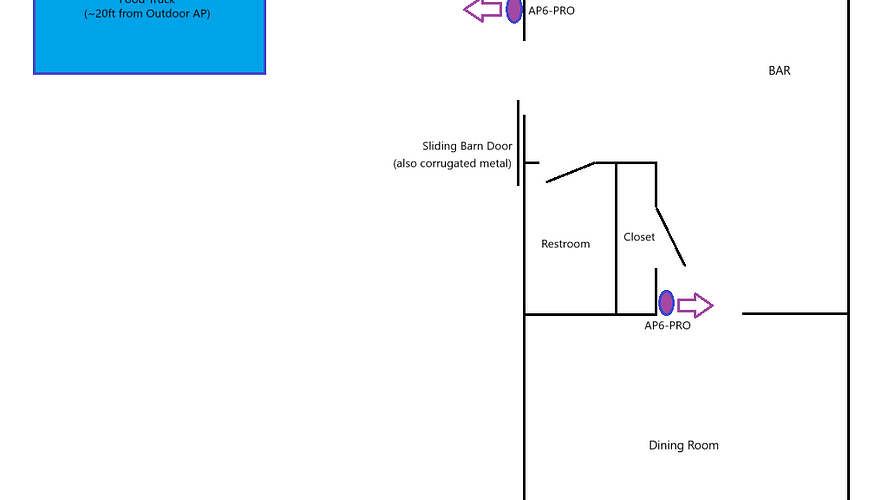I have a small network setup at a venue. There’s a S8-POE switch and two AP6-PRO access points, one indoors, and another outdoors:
There’s a food truck permanently parked outside, and I have the outdoor AP installed specifically to service it. The AP is ~20ft from the food truck, mounted about 15ft above grade, and there are no obstructions between them.
The problem I’m experiencing is that all of the wireless devices in the food trailer (including their Point-of-Sale device and the Wi-Fi VoIP phone they use to take orders) is connecting to the indoor AP. Why is it the “preferred” AP when it’s facing the other way, AND going through four layers of corrugated metal? Obviously, the signal strength is trash. I haven’t gotten complaints yet, but I’d like to solve this before it gets to that point.
Is there a way to “Lock to AP” like UBNT? I don’t see an option.
Which channels do you have the outdoor AP set to ? have you measured the signal in the trailer ?
Some devices may prefer certain channels over others.
1 Like
Like the other person asked, what channels are set. And power settings. Plus, how are these actual positioned/mounted? Ceiling, wall, desk/table, etc…
The AP6Pro are extremely efficient in regards to broadcasting signal. Could be that the way they are positioned is causing the behavior. I have found that high up (ceiling mount, pointing downward) or lower to floor (pointing upward) provides the best coverage spread. On wall, the signal isn’t necessarily going outward from the front/bottom, but off the sides moreso.
Both are wall mounted. The outdoor one is facing the food truck, and the indoor one is facing the opposite direction altogether. The APs are 25-30 feet away from each other.
Both are set to the same channel and full power.
I’ll switch them so they’re not overlapping and update.
Then, if no improvement, I’ll try dropping power of the indoor AP to see what happens.
Thanks for the suggestions.
Bizarre. I put AP_inside on channels 1 & 36 and AP_outside on channels 6 & 157.
Then power cycled the port for AP_inside.
All the devices connected to AP_outside, but showed terrible signal strength for a few seconds before jumping back to AP_inside.
I will head to the site and swap the physical APs. That should tell me if it’s my cable. I don’t want to believe that the AP is bad.
Well this makes sense to a certain point. When clients scan, they start at the bottom and go up sequentially. So the first APs almost every client would see would be the earliest numbers chronologically, i.e. 1 & 36 over 6 & 157. Also keep in mind for 5GHz you’re starting at 36 so it takes a bit to get to 157, certainly more than the jump from 1 to 6.
Do you have fast roaming enabled? And/or BSS Transition? These are roaming technologies that assist in the roaming of a client, but if they’re not enabled, 100% of the roaming decision making is done by the client, which is usually going to be slightly different depending on the vendor. If you’ve ever own an Apple product or a Google Assistant device, you know they really love their 5GHz.
If ultimate speed isn’t needed, I’d do 20 or 40 Mhz channels for 5G, along with good separation between. No need for 80 Mhz bonding if not needed in that type of environment. You may not need high power either, setting to 27dBm EIRP on each may work just fine. This would be for non DFS channels, as DFS power limits will only allow 24dBm EIRP.
And seriously, you may end up only needing one AP going, if it’s up high enough. I can nearly cover a 1/3 acre property with 5G by having one of these up high in attic (around 30 foot up in 2 story house running high power – 30dBm EIRP). I am impressed by that type of coverage. Have not seen that from other vendor products (unifi, cisco, aruba, ruckus).
My reasoning for two APs is that they wanted to cover the whole outdoor area (about a third of an acre by itself), and the building that this network is installed in is an old steel and tin barn that’s been converted / finished inside.
I swapped channels (put the outdoor AP lower on the frequency spectrum so clients will see it first),
set bandwidth to 20MHz,
and changed power of the indoor AP to “Low” while leaving the outdoor AP on “auto”.
The outdoor clients are still connected to the indoor AP.
Power still too high on indoor. Lower to 24 or 27 and see what behavior is like.
Can you run a site survey on a client device? Specifically one that will show received signal levels? Ideally at the furthest point you’d need WiFi and/or a point with the most obstructions.
We can hone in on the best power level to use if we have an idea of what signals the clients are receiving at the furthest points of the WiFi coverage.

